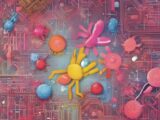
The Role of Diffusion Models in Bioinformatics and Computational Biology
October 17, 2024Introduction
Advances in artificial intelligence (AI) and machine learning (ML) have revolutionized various fields, including bioinformatics and computational biology. Among the cutting-edge AI technologies, generative models such as denoising diffusion models have gained significant traction due to their ability to generate realistic, high-dimensional data. Originally introduced for computer vision and natural language processing tasks, diffusion models have proven their versatility, outperforming traditional deep learning methods in a variety of applications. In bioinformatics, these models have opened new avenues for protein design, drug discovery, and cryo-electron microscopy data analysis, among other tasks. This essay explores the key concepts of diffusion models and highlights their potential applications in bioinformatics and computational biology.
Diffusion Models: An Overview
Diffusion models are a type of generative AI framework designed to produce data samples from complex distributions. These models work by systematically corrupting data with noise through a forward diffusion process, followed by a reverse process that removes the noise to recover the original data. The reverse diffusion process is governed by a trained neural network capable of generating new, clean data samples. Diffusion models have been shown to outperform other generative models such as Generative Adversarial Networks (GANs) and Variational Autoencoders (VAEs), particularly in handling high-dimensional data and generating high-resolution images.
Three primary types of diffusion models are commonly used:
- Denoising Diffusion Probabilistic Models (DDPMs): The most widely used diffusion models for generating high-resolution data, DDPMs operate by progressively adding noise to the original data and then learning to reverse this process.
- Noise-Conditioned Score Networks (NCSNs): These models estimate the score function of a probability density function and apply score-matching techniques to generate samples.
- Score Stochastic Differential Equations (SDEs): These models generalize DDPMs and NCSNs, representing the forward and reverse diffusion processes as stochastic differential equations.
Diffusion models have been successfully applied to various bioinformatics tasks, including protein design, drug discovery, and cryo-electro
Applications of Diffusion Models in Bioinformatics
n microscopy (cryo-EM) data analysis. These applications leverage the generative power of diffusion models to generate new biological data or to denoise noisy data.
- Protein Design and Generation Protein design is a critical task in bioinformatics, essential for drug discovery, understanding protein function, and engineering new biological systems. Traditional protein design methods often rely on deep generative models like VAEs and GANs, which are limited to generating small protein domains. In contrast, diffusion models, such as ProteinSGM and FoldingDiff, can generate large and diverse proteins. These models operate by generating protein structures from noisy data, using a multi-step diffusion process to create complex 3D structures. ProteinSGM, for instance, employs score-based generative diffusion models to generate pairwise distance matrices between residues, which are then used to build native-like protein structures.
- Drug and Small Molecule Design Drug discovery involves finding small molecules that can interact with biological targets, such as proteins, to treat diseases. Diffusion models, like CDGS (Conditional Diffusion Graph Structure) and EDM (Equivariant Diffusion Model), are applied to generate molecular graphs and small molecule structures. These models can predict molecular conformations and interactions with biological targets, leading to faster drug candidate generation. The ability of diffusion models to handle both local and global dependencies within molecular graphs makes them particularly effective in molecular design tasks.
- Protein–Ligand Interaction Modelling Predicting how small molecules (ligands) bind to proteins is crucial for drug discovery and understanding biological function. Diffusion models like DiffBP (Diffusion-Based Protein-Ligand Binding Predictor) outperform traditional auto-regressive methods by generating entire ligand structures that exhibit high binding affinities to specific protein pockets. By leveraging equivariant graph neural networks (GNNs), these models can predict ligand structures that bind to proteins with higher geometrical accuracy and binding affinity, improving the accuracy of drug docking simulations.
- Cryo-electron Microscopy (Cryo-EM) Data Analysis Cryo-EM is an essential imaging technique used to determine the 3D structures of large biomolecular complexes, such as protein complexes, at atomic resolution. However, cryo-EM data are often noisy and low in resolution, making structure reconstruction challenging. Diffusion models have been applied to denoise cryo-EM images and improve the quality of 3D protein structures. For instance, CryoDRGN uses a combination of a Variational Autoencoder (VAE) and diffusion models to generate high-quality protein conformations from cryo-EM data, outperforming traditional image preprocessing methods.
- Single-Cell Data Analysis Diffusion models are also finding applications in single-cell data analysis, particularly in single-cell RNA sequencing (scRNA-seq). These models can denoise gene expression data, impute missing values, and handle the variability in gene expression between individual cells. DEWAKSS, a diffusion model-based tool, employs a K-nearest-neighbour (KNN) graph architecture to denoise scRNA-seq data without over-smoothing the data, preserving the biological variance critical for accurate cell type identification.
Future Applications of Diffusion Models in Bioinformatics
The versatility and power of diffusion models make them suitable for tackling numerous challenges in bioinformatics and computational biology. Some promising areas for future applications include:
- 3D Genomics Data Analysis: Diffusion models can be applied to denoise chromosomal contact matrices from Hi-C data, improving the accuracy of 3D genome conformation modelling.
- Single-Cell Inference: Diffusion models could be used to infer missing modalities in single-cell ‘omics data, such as predicting RNA-seq data from ATAC-seq data, or decomposing multi-cell spots in spatial transcriptomics into single-cell data.
- DNA Regulatory Element Design: Generative models, such as diffusion models, can be applied to design regulatory elements like enhancers, which control gene expression, aiding synthetic biology and gene therapy.
- Cryo-EM Image Denoising: Diffusion models trained on cryo-EM images at various noise levels could effectively denoise these images, leading to more accurate 3D reconstructions of protein complexes.
Limitations of Diffusion Models
Despite their advantages, diffusion models have some limitations that need to be addressed. The training process is computationally expensive due to the long sampling time required for noise introduction and removal. Furthermore, diffusion models demand significant computational resources compared to GANs and VAEs, which may limit their real-time applications. Efforts to streamline the training process and reduce computational overhead will be essential to fully realize the potential of diffusion models in bioinformatics.
Conclusion
Diffusion models represent a powerful generative AI framework with the potential to revolutionize bioinformatics and computational biology. Their ability to handle high-dimensional, noisy data and generate realistic biological data samples makes them ideal for tasks such as protein design, drug discovery, and cryo-EM data analysis. As computational methods continue to evolve, diffusion models will likely play a central role in addressing some of the most pressing challenges in modern biology, paving the way for new discoveries in protein engineering, genomics, and molecular biology.
Reference
Guo, Z., Liu, J., Wang, Y., Chen, M., Wang, D., Xu, D., & Cheng, J. (2024). Diffusion models in bioinformatics and computational biology. Nature reviews bioengineering, 2(2), 136-154


















